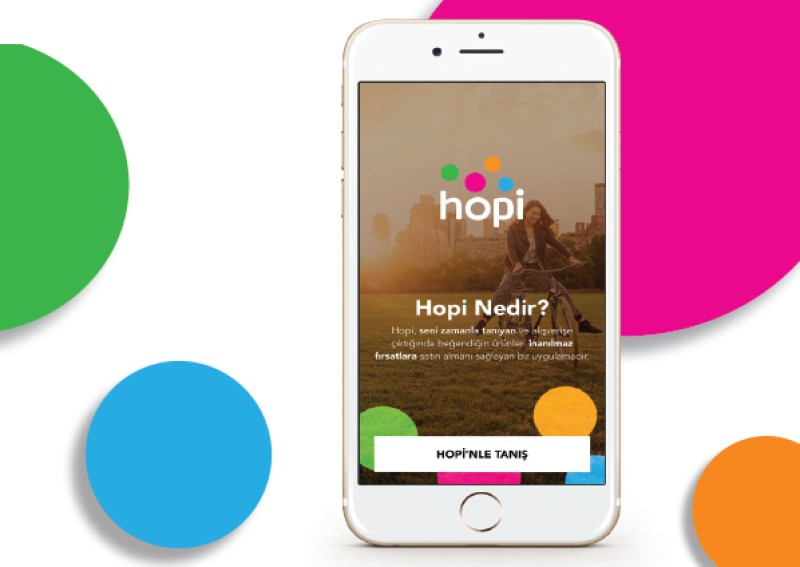Mobile is becoming a channel of choice for the retail industry. Global mobile retail revenues are expected to hit $626 billion by 2018, up from $204 billion in 2014, according to Goldman Sachs. It’s no wonder that retailers are scrambling to prioritize the mobile channel.
Progressive retailers are leveraging the unique personalization potential that mobile affords to build apps and create programs that resonate with customers. One such company is Hopi, a mobile app firm based in Turkey. It is designed to match consumers with customized product and campaign offers from participating merchants according to their preferences, shopping habits, and expectations. The program is the latest business venture from Turkey’s Boyner Group, which owns more than 500 physical retail stores and fashion brands in the region. So far more than 2 million customers and 30 brands have signed up to participate in the program since it launched in April 2015.
We recently sat down with Onur Erbay, general manager of Hopi, and Elif Atesok Satiroglu, vice president of Boyner Group in charge of strategy and new business development, to discuss the ups and downs of expanding into the mobile retail environment.
Customer Strategist: How do you define Hopi, and what’s the value proposition for customers?
Onur Erbay: We define Hopi as “the app of shopping” for Turkish retail sector. Hopi is a smartphone app…enabling a coalition of leading brands. Hopi provides a personalized shopping experience for customers, focused on special campaigns in line with the customers’ choices using its big data infrastructure. On the merchant side, Hopi offers a coalition of brands and provides a platform for personalized marketing campaigns. [It is designed to be] a major communication and customer acquisition channel for merchants.
Elif Satiroglu: Hopi creates a data ecosystem that generates valuable insight about its user base in order to communicate the most relevant campaigns to the most interested parties. We aim to have a coalition of 65 brands by the end of the year and provide our customers with a shopping experience covering all of their needs. As the merchant base expands, Hopi will be able to offer a 360-degree shopping experience for its customers and create a new retail ecosystem.

CS: Why go mobile-first to create the Hopi platform? Why was it important to focus on the mobile channel as a way to interact with consumers?
ES: We see mobile as the leading platform of retail in the near future. Almost every indicator of online shopping suggests that the traffic will be converted to mobile in the next decade. Today, e-commerce companies might receive up to 50 percent of their traffic from mobile channels, depending on the day. The numbers are climbing all around the world, thus we [Boyner Group] are heading to the direction of mobile. Today, smartphone penetration in Turkey is 42 percent, by the end of 2015 it is expected to reach 55 percent. So, it is a calculated decision.
Nearly 10 million of the 16.5 million unique customers shopping at Boyner Group stores have smartphones. As a Group, we aim to provide the best customer experience across all lines of commerce; mobile is the most prominent channel to start with. We support our mobile strategy with our online channels and offline stores. As mobile usage continues to accelerate, we hope to gain around 15 million Hopi users in about three or four years.
CS: Can you provide some examples of the types of personalization and customization Hopi provides?
OE: Hopi prides itself to know its customers just like a friend would. Apart from analyzing customer shopping habits and interests, Hopi also benefits from the opportunities Boyner Group stores present. We installed 5,500 iBeacons across our network. They are located at store entrance and exit points, and on shelf locations. Therefore, we can identify people who come to a particular store but leave without making a purchase. We can learn what these people like or dislike, and show them relevant offers to trigger a purchase next time they come into the store. In addition to this, we can analyze frequent locations where customers visit. If you visit coffee houses often, we can show you a coffee house offer. If you like buying shoes, we offer you a campaign in the shoe department just as you are coming close to the related area. For companies like hotels and movie theaters, we can send real-time offers to people who we identify as interested in them.
Hopi also eliminates the irrelevant offers once the customer starts using the system. If the customer always buys size 4 pants and suddenly starts to buy size 6, Hopi assesses the customer to learn if she has put on weight or is pregnant, based on her next moves. If the same customer is looking for a cradle, then come instant offers on shopping for the baby. Otherwise, Hopi might offer a membership to the gym.
CS: What lessons have you learned about customer interactions since launch?
OE: For a holistic shopping app like the one we designed, simplicity is the key. You have to implement the features one by one. Especially if you are reaching your customers through a mobile application, customers do not embrace a mobile app or any feature of the app they cannot understand in a short period of time. They need to get accustomed to the system and the interface first. Once they start to use the basics, you might add new features. Therefore, our strategy will be to acquire customers by providing the simplest and most relevant customer experiences, then enrich the experience as adoption level increases with more tailored communications.
More importantly, we shouldn’t forget that there are many important customer touchpoints across the whole purchasing funnel besides mobile. Experience inside a member partner’s store, website, mobile website, or call center are also very important, and they should be designed accordingly to complement the shopping experience offered by the app.
As we have mentioned, smartphone penetration is growing significantly, however users are at different stages of technology maturity. Some of the users use six or seven apps every day, while others have the most sophisticated smartphone models but cannot remember their store passwords. Acquisition and retention strategies should cover all of these levels. Simplicity has to be the core structure.
CS: You’ve gotten nearly 2 million downloads since Hopi launched in April. To what do you attribute the program’s success?
ES: Hopi received a great amount of attention from the moment it was launched and hit a milestone by being downloaded by 1 million customers in 14 days. After nearly two months, 2 million customers downloaded the app and started using it. We designed a very aggressive media and marketing plan and launched Hopi with a big campaign. Marketing was extremely important to create awareness and communicate the value we will create for our users.
Though being a very successful plan, marketing was not the only reason behind the app’s success. Boyner Group’s stores, over 500 all around Turkey, and the salespeople’s physical touch, were also very significant. Thanks to the physical stores of Boyner Group and other member companies in the network, we were able to increase the number of downloads within the stores via face-to-face communication.
CS: What’s been your biggest challenge in this initiative?
OE: Because Hopi is a mobile app and the value proposition is offering personalized campaigns, people cannot grasp the real benefit of the system without using it. Additionally, our loyalty award system is a brand new concept that provides very lucrative opportunities for customers. Therefore communicating the value and how the award system works is a challenge.
And since Boyner Group stores were an important channel for customer acquisition, introducing and teaching Hopi to the sales staff was a difficult challenge for us to overcome, as well.
Designing and refining the process inside the stores required great effort. We needed to define how the sales representatives greet customers with a Hopi message, place the marketing communication materials inside the stores, and transform the cashier processes. This was very challenging, since we institutionalized a process where customers show their QR codes and complete their shopping. Educating customers and the store staff is still a work in progress, and we still have a long way to optimize this two-way communication.
CS: What’s been the biggest success so far?
OE: Hundreds of thousands of people used a QR code for first time with Hopi. When we think about what we want to do in the future, this field experience and power are very encouraging. Whatever we launch in the future related to Hopi, we have a huge field force who will help our customers understand how to use it.
As Elif mentioned, another achievement was that one of the merchants we are working with achieved 50 percent like-for-like (LFL) growth in the period we had a campaign together, surpassing their YTD LFL growth rate of 16 percent. These are amazing statistics to start with.
CS: How will you continue to keep customers top-of-mind and evolve the app to meet changing customer needs?
ES: We are constantly monitoring feedback and results from our customers’ experience. We use customer research methods ranging from surveys to structured field observations to develop the app and its proposition both from a merchant network/campaigns angle and from a customer experience angle. Today, customers have many means to give opinions about the product ranging from call centers to social media. We listen very closely on all channels. We receive feedback from Boyner Group companies and merchants and implement new features to our business plans.
CS: What are your next steps?
OE: Our ambition is to reach 5 million users and 65 merchants by the end of first year, so we will expand our user base and work on acquisition. We have a strong marketing plan and new product features planned for the rest of the year, including mobile payments. Adding a payment tool within the app will contribute to our goal of becoming “the app of shopping” and make a big step towards offering a 360-degree shopping experience.

CS: What advice do you have for other executives who are exploring mobile and data-driven initiatives?
ES: Customer experience is extremely important; it is very easy to install and uninstall mobile products. Therefore, the cost of a bad experience is extremely high in this environment. A solution that is very highly perceived in the office might not work in the field with the customers. You need to constantly listen to your customers and measure their reactions, assess their needs, and react accordingly.
Regarding personalization, forming an organization around the technology capability you are building is very important. No matter how much we automate or which tool we incorporate, there is a strong human element about personalization, which must be fulfilled by very capable people.
And, remember that building a business around mobile and data requires patience and perseverance. Since a lot of things are new, we should be comfortable with trying, making mistakes, identifying things that work and scaling them, and eliminating things that do not. The Hopi team is very excited with the results we have achieved, but we are aware that there are a lot of mysteries to be solved and lots of milestones to be reached.

















